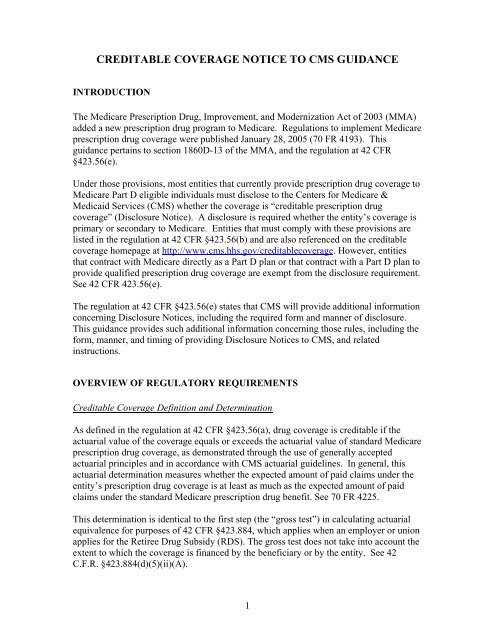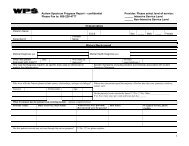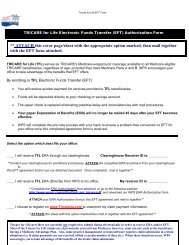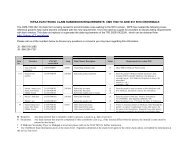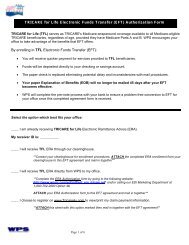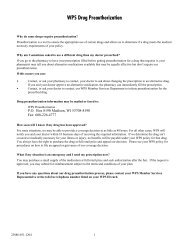Creditable Coverage - WPS
Creditable Coverage - WPS
Creditable Coverage - WPS
You also want an ePaper? Increase the reach of your titles
YUMPU automatically turns print PDFs into web optimized ePapers that Google loves.
CREDITABLE COVERAGE NOTICE TO CMS GUIDANCE<br />
INTRODUCTION<br />
The Medicare Prescription Drug, Improvement, and Modernization Act of 2003 (MMA)<br />
added a new prescription drug program to Medicare. Regulations to implement Medicare<br />
prescription drug coverage were published January 28, 2005 (70 FR 4193). This<br />
guidance pertains to section 1860D-13 of the MMA, and the regulation at 42 CFR<br />
§423.56(e).<br />
Under those provisions, most entities that currently provide prescription drug coverage to<br />
Medicare Part D eligible individuals must disclose to the Centers for Medicare &<br />
Medicaid Services (CMS) whether the coverage is “creditable prescription drug<br />
coverage” (Disclosure Notice). A disclosure is required whether the entity’s coverage is<br />
primary or secondary to Medicare. Entities that must comply with these provisions are<br />
listed in the regulation at 42 CFR §423.56(b) and are also referenced on the creditable<br />
coverage homepage at http://www.cms.hhs.gov/creditablecoverage. However, entities<br />
that contract with Medicare directly as a Part D plan or that contract with a Part D plan to<br />
provide qualified prescription drug coverage are exempt from the disclosure requirement.<br />
See 42 CFR 423.56(e).<br />
The regulation at 42 CFR §423.56(e) states that CMS will provide additional information<br />
concerning Disclosure Notices, including the required form and manner of disclosure.<br />
This guidance provides such additional information concerning those rules, including the<br />
form, manner, and timing of providing Disclosure Notices to CMS, and related<br />
instructions.<br />
OVERVIEW OF REGULATORY REQUIREMENTS<br />
<strong>Creditable</strong> <strong>Coverage</strong> Definition and Determination<br />
As defined in the regulation at 42 CFR §423.56(a), drug coverage is creditable if the<br />
actuarial value of the coverage equals or exceeds the actuarial value of standard Medicare<br />
prescription drug coverage, as demonstrated through the use of generally accepted<br />
actuarial principles and in accordance with CMS actuarial guidelines. In general, this<br />
actuarial determination measures whether the expected amount of paid claims under the<br />
entity’s prescription drug coverage is at least as much as the expected amount of paid<br />
claims under the standard Medicare prescription drug benefit. See 70 FR 4225.<br />
This determination is identical to the first step (the “gross test”) in calculating actuarial<br />
equivalence for purposes of 42 CFR §423.884, which applies when an employer or union<br />
applies for the Retiree Drug Subsidy (RDS). The gross test does not take into account the<br />
extent to which the coverage is financed by the beneficiary or by the entity. See 42<br />
C.F.R. §423.884(d)(5)(ii)(A).<br />
1
For plans that have multiple benefit options, the regulation requires that entities apply the<br />
gross test separately for each benefit option. See 42 CFR §423.884(d) (5) (iv). A benefit<br />
option is defined at 42 CFR §423.882 as a particular benefit design, category of benefits,<br />
or cost-sharing arrangement offered within a group health plan. Benefit option refers to<br />
the different categories of benefits and different plan design options under a given Type<br />
of <strong>Coverage</strong> (e.g., HMO, PPO, Indemnity). Benefit options are referenced on the<br />
disclosure form as “Options”.<br />
For purposes of the Disclosure Notice to CMS, we require a separate disclosure for each<br />
Type of <strong>Coverage</strong> sponsored by an Entity (e.g., Medicaid, SPAP, Employer Plan, Church<br />
Plan, Standardized Medigap Plan, Pre-standardized Medigap Plan).<br />
III. POLICY GUIDANCE<br />
The following are clarifications and other guidance relating to the above requirements:<br />
<strong>Creditable</strong> <strong>Coverage</strong> Disclosure from Entity to CMS<br />
The regulation at 42 CFR §423.56(e) requires all entities described in the regulation at 42<br />
CFR §423.56(b) disclose to CMS whether the prescription drug coverage that is offered<br />
to Medicare Part D eligible individuals is creditable or non-creditable.<br />
Form and Manner of <strong>Creditable</strong> <strong>Coverage</strong> Disclosure from Entity to CMS<br />
An entity is required to provide the Disclosure Notice through completion of the<br />
disclosure form on the CMS <strong>Creditable</strong> <strong>Coverage</strong> Disclosure Web Page at<br />
http://www.cms.hhs.gov/creditablecoverage. This method of transmission is convenient<br />
and will take minimal time to complete, and is the sole method for compliance with the<br />
requirement.<br />
Who Must Provide the Disclosure Notice to CMS<br />
The Disclosure Notice is required to be provided to CMS by certain entities listed at 42<br />
CFR §423.56(b) that are not excluded at §423.56(e). These include:<br />
1. Group health plans, including those offered by employers; union/Taft-Hartley plans;<br />
church, Federal, State and local government, and other group-sponsored plans;<br />
2. Governmental sponsored plans, including Medicaid; State Pharmaceutical Assistance<br />
Programs (SPAPs); State High Risk Pools;<br />
3. Military <strong>Coverage</strong>, including the Veterans’ Administration coverage and TRICARE;<br />
4. Individual health insurance;<br />
5. Indian Health Service; Tribe or other Tribal Organizations; Urban Indian<br />
Organizations; and<br />
6. Medigap (Medicare Supplement) plans, including standardized plans H, I or J; prestandardized<br />
plans; waiver State plans; and plans with innovative benefits.<br />
2
The entities exempted under 42 CFR §423.56(e) include PDPs, MA-PDs, and PACE or<br />
cost-based HMOs or CMPs that provide “qualified Part D coverage” within the meaning<br />
of 42 CFR §423.100.<br />
The regulation at 42 CFR §423.884(c)(2)(iv) requires that a plan sponsor provide an<br />
attestation that its prescription drug coverage is at least actuarially equivalent to the<br />
standard prescription drug coverage under Part D as part of the application for the Retiree<br />
Drug Subsidy (RDS) . Therefore, because the actuarial equivalence standard includes the<br />
creditable coverage standard, a sponsor that has been approved for the Retiree Drug<br />
Subsidy is exempt from filing the Disclosure Notice with CMS with respect to those<br />
qualified covered retirees for which the Sponsor is claiming the Retiree Drug Subsidy.<br />
The sponsor’s RDS application serves as its disclosure to CMS under 42 CFR<br />
§423.56(e).<br />
Timing of <strong>Creditable</strong> <strong>Coverage</strong> Disclosure from Entity to CMS<br />
The Disclosure Notice must be made to CMS on an annual basis, and upon any change<br />
that affects whether the drug coverage is creditable. The initial Disclosure Notice must<br />
be provided by March 31, 2006.<br />
At a minimum, disclosure to CMS must be made at the following times:<br />
Additional Guidance<br />
1. For plan years that end in 2006, disclosure of creditable coverage status<br />
must be provided no later than March 31, 2006.<br />
2. For plan years that end in 2007 and beyond, disclosure of creditable<br />
coverage status must be provided within 60 days after the beginning date<br />
of the plan year for which the entity is providing the disclosure to CMS.<br />
3. Within 30 days after the termination of the prescription drug plan ; and<br />
4. Within 30 days after any change in the creditable coverage status of the<br />
prescription drug plan.<br />
CMS may release Question and Answers relating to <strong>Creditable</strong> <strong>Coverage</strong> issues from<br />
time to time on the CMS website under the MMA Questions and Issues Database website<br />
which can be found at: http://www.cms.hhs.gov/<br />
IV. CONTENT OF THE DISCLOSURE NOTICE TO CMS<br />
Listed below are the required data fields in the Disclosure Notice form that must be<br />
populated in order to generate the Disclosure Notice. For entities with subsidiaries<br />
(division, line of business, operating unit, control group, etc.), one disclosure form can be<br />
submitted to CMS for the entire entity if the plan year is the same for all<br />
subsidiaries/divisions, or an additional form can be submitted for each subsidiary<br />
(division, line of business, operating unit, control group, etc.) with the subsidiary-specific<br />
information.<br />
3
Name of Entity Offering <strong>Coverage</strong>. This is the name of the entity that is providing or<br />
sponsoring the plan of benefits to Medicare eligible individuals such as an employer, a<br />
union, the Veterans’ Administration, or a Medigap issuer. It is not the name of any carrier<br />
that the entity may have contracted with for insurance coverage or for administration of<br />
its benefit plan.<br />
Federal Tax Identification Number of the Entity. For entities that have multiple<br />
subsidiaries (divisions, line of businesses, operating units, control groups, etc.) that are all<br />
covered under the same type of coverage, the Federal Tax Identification Number (also<br />
known as the Employer Identification Number, or EIN) for the Parent Company may be<br />
used when completing the entity’s EIN information for the entire company. If the form is<br />
completed separately for individual subsidiaries (divisions, line of businesses, operating<br />
units, control groups, etc.), the EIN for each subsidiary should be provided.<br />
Street Address, including the City, State and Zip Code of the Entity. For entities that<br />
have many subsidiaries (divisions, line of businesses, operating units, control groups,<br />
etc.) under the same type of coverage, the Street Address for the Parent Company may be<br />
used when completing the entity’s information.<br />
Phone Number of the Entity. For entities with many subsidiaries (divisions, line of<br />
businesses, operating units, control groups, etc.) that have the same type of coverage, the<br />
phone number for the Parent Company may be used when completing the entity’s<br />
information.<br />
Type of <strong>Coverage</strong>. The Type of <strong>Coverage</strong> (e.g., Medicaid, VA, SPAP) that must<br />
provide disclosure are those listed under the regulation at 42 CFR §423.56(b) that are not<br />
excluded under 42 CFR §423.56(e).<br />
Number of Options offered by the Entity. This is the total number of benefit options<br />
as defined under 42 CFR §423.882 that the entity is offering to Medicare eligible<br />
individuals. For example, an employer plan may offer an HMO option, a PPO option and<br />
an indemnity option, and a Medigap issuer may offer multiple Medigap policies that<br />
include prescription drug coverage.<br />
<strong>Creditable</strong> <strong>Coverage</strong> Status of Options offered by the Entity. If the Options offered<br />
by the entity are either all creditable or all non-creditable, the entities/plan sponsors may<br />
provide aggregated data in the Disclosure Notice for all options under the Plan. If some<br />
of the Options offered are creditable and some are not creditable, entities/plan sponsors<br />
may combine the data for Options that are creditable and combine the data for those<br />
Options that are not creditable in the Disclosure Notice.<br />
Period covered by Disclosure Notice. An entity is required to provide the Disclosure<br />
Notice to CMS on an annual basis. Each entity must provide the beginning and ending<br />
calendar date(s) of the Plan Year for which such entity is providing the disclosure to<br />
CMS. For purposes of the Disclosure Notice to CMS, CMS defines “Plan Year” as the<br />
beginning and ending date of the entity’s annual renewal or contract period.<br />
4
Number of Part D Eligible Individuals expected to be covered under these Plan(s) as<br />
of the Beginning Date of the Plan Year. While CMS recognizes that many entities will<br />
not be able to provide an exact number of Part D eligible individuals, entities should<br />
estimate the number of covered Part D eligible individuals under the Options offered<br />
under the type of coverage for which they are providing the Disclosure Notice to CMS.<br />
Estimate Number of individuals expected to be covered through an Employer/Union<br />
group health Retiree Plan. Group Health Plans entities should estimate the number of<br />
Part D eligible individuals covered under retiree plans for which they are providing the<br />
Disclosure Notice to CMS. All other entities offering other Types of <strong>Coverage</strong> should<br />
indicate a zero (0) in this field.<br />
Date of Notice of <strong>Creditable</strong> <strong>Coverage</strong> provided to Part D Eligible Individuals.<br />
An entity must disclose to CMS the latest calendar date on which it provided the required<br />
disclosure to Part D eligible individuals of creditable or non-creditable coverage (i.e.,<br />
mailed, personally distributed to Part D eligible individuals, etc.) as required under 42<br />
CFR §423.56 (c), (d) & (f).<br />
Change in <strong>Creditable</strong> <strong>Coverage</strong> status of previously disclosed information to CMS.<br />
Entities also must provide a Disclosure Notice to CMS if the creditable coverage status of<br />
a Type of <strong>Coverage</strong> or any of the Options previously disclosed to CMS undergoes a<br />
change in creditable coverage status. This includes an entity changing the coverage<br />
offered so that it is no longer creditable or terminating a creditable coverage plan or<br />
option.<br />
An entity must disclose to CMS the date that on which it provided the required disclosure<br />
to Part D Eligible Individuals under 42 CFR §423.56 (f)(2). The date should be the<br />
calendar date that disclosure of a Change in <strong>Creditable</strong> <strong>Coverage</strong> status was provided<br />
(i.e., mailed, posted, personally distributed to Part D Eligible Individuals, etc.)<br />
Name, Title and Email of the Entity’s Authorized Individual. An individual employed<br />
by the entity and completing the form must provide his or her name, title and email.<br />
Date of Disclosure to CMS. The entity’s authorized individual must provide the date on<br />
which he or she is submitting the disclosure to CMS.<br />
V. CONTACT FOR FURTHER INFORMATION<br />
You should visit the CMS website link related to creditable coverage issues at:<br />
http://www.cms.hhs.gov/creditablecoverage<br />
5


